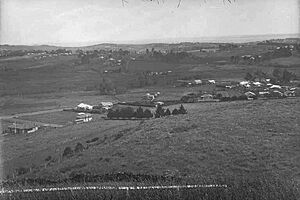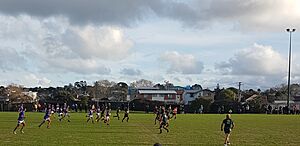Ōwairaka facts for kids
Quick facts for kids
Ōwairaka
|
|
|---|---|
|
Suburb
|
|

Pak'nSave supermarket on New North Road
|
|
| Country | New Zealand |
| Local authority | Auckland |
| Electoral ward | Albert-Eden-Puketāpapa ward |
| Local board | Albert-Eden Local Board |
| Area | |
| • Land | 140 ha (350 acre) |
| Population
(June 2023)
|
|
| • Total | 6,030 |
|
|
||
Ōwairaka is a lively suburb in Auckland, New Zealand's biggest city. It is managed by the Auckland Council. For a long time, Ōwairaka was mostly countryside. But in the 1930s, more and more houses were built, and it became a suburb.
Ōwairaka is famous for its Owairaka Athletic Club. This club became very well known in the 1960s thanks to amazing coach Arthur Lydiard and star athletes like Murray Halberg and Peter Snell.
Contents
Ōwairaka's Location and Landscape

Ōwairaka is located in the southern part of what used to be the Mount Roskill area. To its south, you'll find the Oakley Creek and the Southwestern Motorway. North of the suburb is the volcanic hill called Ōwairaka / Mount Albert.
Important roads in Ōwairaka include New North Road, Richardson Road, and Owairaka Avenue.
A Look Back at Ōwairaka's History
The name Ōwairaka comes from the volcanic hill Ōwairaka / Mount Albert. The name is linked to Wairaka, an important Māori ancestor. She was the daughter of Toroa, who was the captain of the Mātaatua voyaging waka (canoe). Wairaka came to Auckland to avoid a marriage she did not want. She then settled her people on the volcano.
Early Māori Settlements
In the early 1700s, the Auckland isthmus (the narrow strip of land connecting two larger landmasses) was home to many Waiohua tribes. Ōwairaka / Mount Albert was the westernmost hill-top pā (fortified village) of the Waiohua. It had many terraces and gardens for growing food.
After a conflict between the Waiohua and Ngāti Whātua tribes in the mid-1700s, the area became part of Ngāti Whātua's rohe (territory). The Ngāti Whātua people were fewer in number than the Waiohua. They preferred to live closer to the sea. Because of this, much of the Ōwairaka area was not used as much.
Becoming Part of the Crown
On June 29, 1841, Ngāti Whātua sold Ōwairaka to the Crown (the government). This sale was part of a large 12,000-acre section of land. The land in Ōwairaka was rough and uneven. This meant it grew slower than other parts of the Auckland area.
In the 1860s, New North Road was built. This road provided access to the area and was an alternative to the Great North Road. In October 1866, the Mt Albert District Highway Board was created. This was the first local government in the area, set up to manage New North Road and nearby places.
Growth and Development
The first school in Ōwairaka opened on September 10, 1929. It was first called Richardson Road School. However, in 1930, parents asked for the name to be changed. It then became Owairaka School.
In the early 1900s, trams helped the suburbs along New North Road grow. While most other suburbs got tram stations in the 1910s, the Ōwairaka tram stop did not open until 1936. From the late 1930s, the government started building many state houses in Ōwairaka. By the 1940s, the suburb was a mix of rural areas and new suburban homes.
In 1943, the Owairaka Athletic Club was started at Anderson Park. It later moved to the Lovelock Track in Mount Roskill in 1961. In the 1960s, the club became very famous for its middle and long-distance running. This was thanks to coach Arthur Lydiard. The club produced national and international champions, including Murray Halberg and Peter Snell, who was named New Zealand Athlete of the Century.
In the 1970s, Ōwairaka became a hub for Māori and Pasifika communities. Many families moved there as other central Auckland suburbs became more expensive. In the 1990s and 2000s, Ōwairaka also became a key area for Chinese and Somali communities.
Ōwairaka's Population and People
Ōwairaka covers about 1.40 square kilometers. As of 2023, it has an estimated population of about 5,256 people. This means there are about 3,754 people living in each square kilometer.
Population Changes Over Time
The population of Ōwairaka has changed a bit over the years:
- In 2006, there were 4,941 people.
- In 2013, the population grew to 5,280.
- In 2018, it reached 5,634 people.
- In 2023, the population was 5,256.
This shows a small decrease since 2018, but it's still close to the numbers from 2013.
Who Lives in Ōwairaka?
The 2023 New Zealand census showed that Ōwairaka had 5,256 people. There were slightly more males than females. About 18.6% of the people were under 15 years old. Almost half (48.9%) were aged 30 to 64.
People in Ōwairaka come from many different backgrounds:
- About 43.1% are European (Pākehā).
- 9.4% are Māori.
- 17.2% are Pasifika.
- 37.9% are Asian.
- 6.0% are from the Middle East, Latin America, and Africa (MELAA).
Most people (91.4%) speak English. Other languages spoken include Māori (2.1%), Samoan (4.2%), and many others (33.5%). Almost half of the people (46.8%) were born outside New Zealand.
Beliefs and Work
When it comes to religion:
- 33.3% are Christian.
- 6.8% are Hindu.
- 7.3% are Muslim.
- A large group (43.0%) said they had no religion.
Many adults in Ōwairaka have completed higher education. About 39.4% have a bachelor's degree or higher. Most people aged 15 and over are employed, with 58.4% working full-time.
Places to Visit and Things to Do in Ōwairaka
Ōwairaka has several parks and community spots:
- Anderson Park: This is the home ground for the Mount Albert-Ponsonby association football (soccer) club.
- Murray Halberg Park: Here you'll find the rugby league club Marist Saints and the Owairaka Sea Scouts.
- Owairaka Park: This park is where the famous Owairaka Athletic Club is based.
- Te Whitinga Footbridge: This bridge, also known as the Hendon Footbridge, opened in 2017. It crosses the Southwestern Motorway and connects Kukuwai Park in Ōwairaka to the suburb of New Windsor.
Schools in Ōwairaka
Ōwairaka District School is a primary school for students in years 1 to 6. It has about 320 students. For high school, local students usually attend Mount Albert Grammar School.
Ōwairaka's Weather
| Climate data for Ōwairaka (1991–2020 normals, extremes 1949–2008) | |||||||||||||
|---|---|---|---|---|---|---|---|---|---|---|---|---|---|
| Month | Jan | Feb | Mar | Apr | May | Jun | Jul | Aug | Sep | Oct | Nov | Dec | Year |
| Record high °C (°F) | 28.7 (83.7) |
30.5 (86.9) |
28.7 (83.7) |
26.7 (80.1) |
24.4 (75.9) |
21.1 (70.0) |
20.0 (68.0) |
20.0 (68.0) |
21.5 (70.7) |
23.5 (74.3) |
25.3 (77.5) |
27.8 (82.0) |
30.5 (86.9) |
| Mean daily maximum °C (°F) | 23.5 (74.3) |
24.0 (75.2) |
22.7 (72.9) |
20.4 (68.7) |
18.0 (64.4) |
15.7 (60.3) |
14.9 (58.8) |
15.4 (59.7) |
16.7 (62.1) |
17.9 (64.2) |
19.6 (67.3) |
21.8 (71.2) |
19.2 (66.6) |
| Daily mean °C (°F) | 19.4 (66.9) |
20.0 (68.0) |
18.6 (65.5) |
16.4 (61.5) |
14.3 (57.7) |
12.1 (53.8) |
11.1 (52.0) |
11.6 (52.9) |
12.8 (55.0) |
14.3 (57.7) |
15.8 (60.4) |
18.0 (64.4) |
15.4 (59.7) |
| Mean daily minimum °C (°F) | 15.4 (59.7) |
16.0 (60.8) |
14.5 (58.1) |
12.4 (54.3) |
10.6 (51.1) |
8.4 (47.1) |
7.2 (45.0) |
7.7 (45.9) |
9.0 (48.2) |
10.6 (51.1) |
12.0 (53.6) |
14.3 (57.7) |
11.5 (52.7) |
| Record low °C (°F) | 6.8 (44.2) |
6.9 (44.4) |
2.0 (35.6) |
2.1 (35.8) |
0.0 (32.0) |
−2.5 (27.5) |
−2.3 (27.9) |
−1.3 (29.7) |
0.2 (32.4) |
2.2 (36.0) |
4.1 (39.4) |
5.2 (41.4) |
−2.5 (27.5) |
| Average rainfall mm (inches) | 73.7 (2.90) |
65.6 (2.58) |
90.5 (3.56) |
101.8 (4.01) |
108.5 (4.27) |
124.1 (4.89) |
146.8 (5.78) |
116.0 (4.57) |
103.0 (4.06) |
100.8 (3.97) |
89.8 (3.54) |
92.6 (3.65) |
1,213.2 (47.78) |
| Source: NIWA (rainfall 1981–2010) | |||||||||||||





